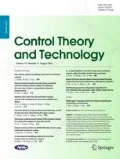Abstract
The paper analyzes and compares the phase margins of four active disturbance rejection control (ADRC) designs, which are based on different common-used extended state observers (ESOs) of various orders, for second-order systems. The quantitative results indicate that, besides good dynamic response, ADRC can guarantee enough phase margin. It is also proved that by decreasing the order of ESO, the phase margin can be increased. Furthermore, it is demonstrated that the phase margins of the ADRC-based systems can be almost uninfluenced by the uncertainties of the system parameters. Finally, the theoretical results are verified by both simulations and experiments on a motion control platform.











Similar content being viewed by others
References
Han, J. (1995). The extended state observer of a class of uncertain systems. Control and Decision, 10(1), 85–88 (in Chinese).
Han, J. (1998). Auto-disturbance rejection control and its applications. Control and Decision, 13(1): 19C23 (in Chinese).
Han, J. (2009). From PID to active disturbance rejection control. IEEE Transactions on Industrial Electronics, 56(3), 900–906.
Xue, W. C., Madonski, R., Gao, Z. Q., Huang, Y., & Lakomy, K. (2017). Add-on module of active disturbance rejection for set-point tracking of motion control systems. IEEE Transactions on Industry Applications, 53(4), 4028–4040.
Sun, L., Li, D., Hu, K., et al. (2016). On tuning and practical implementation of ADRC: A case study from a regenerative heater in a 1000MW power plant. Industrial and Engineering Chemistry Research, 55(23), 6686–6695.
Xiang, G. F., Huang, Y., Yu, J. R., et al. (2018). Intelligence evolution for service robot: An ADRC perspective. Control Theory and Technology, 16(4), 324–335.
Zheng, Q., & Gao, Z. Q. (2018). Active disturbance rejection control: Some recent experimental and industrial case studies. Control Theory and Technology, 16(4), 301–313.
Madonski, R., Ramirez-Neria, M., Stankovic, M., et al. (2019). On vibration suppression and trajectory tracking in largely uncertain torsional system: An error-based ADRC approach. Mechanical Systems and Signal Processing, 134, 106300.
Yao, S., Gao, G., & Gao, Z. (2021). On multi-axis motion synchronization: The cascade control structure and integrated smcCadrc design. ISA Transactions, 109, 259–268.
Zuo, Y., Mei, J., Jiang, C., et al. (2021). Linear active disturbance rejection controllers for PMSM speed regulation system considering the speed filter. IEEE Transactions on Power Electronics, 36(12), 14579–14592.
Huang, Y., & Xue, W. C. (2014). Active disturbance rejection control: Methodology and theoretical analysis. ISA Transactions, 53(4), 963–976.
Guo, B. Z., Wu, Z. H., & Zhou, H. C. (2016). Active disturbance rejection control approach to output-feedback stabilization of a class of uncertain nonlinear systems subject to stochastic disturbance. IEEE Transactions on Automatic Control, 61(6), 1613–1618.
Chen, S., Bai, W. Y., Hu, Y., et al. (2020). On the conceptualization of total disturbance and its profound implications. Science China Information Sciences, 63(2), 129201.
Zhong, S., Huang, Y., & Guo, L. (2020). A parameter formula connecting PID and ADRC. Science China Information Sciences, 63(9), 192203.
Liu, W., & Zhao, T. (2021). An active disturbance rejection control for hysteresis compensation based on neural networks adaptive control. ISA Transactions, 109, 81–88.
Tian, G., & Gao, Z. Q. (2007). Frequency response analysis of active disturbance rejection based control system. In: Proceedings of the 16th IEEE International Conference on Control Applications Part of IEEE Multi-conference on Systems and Control, pp. 1595-1599. Singapore.
Xue, W. C., & Huang, Y. (2015). Performance analysis of active disturbance rejection tracking control for a class of uncertain LTI systems. ISA Transactions, 58, 133–154.
Wu, D., & Chen, K. (2013). Frequency-domain analysis of nonlinear Active Disturbance Rejection Control via the describing function method. IEEE Transactions on Industrial Electronics, 60(9), 3906–3914.
Zhong, S., Huang, Y. (2019). Comparison of the phase margins of different ADRC designs. In: Proceedings of the Chinese Control Conference, 1280-1285. Guangzhou, China.
Yoo, D., Yau, S. T., & Gao, Z. Q. (2007). Optimal fast tracking observer bandwidth of the linear extended state observer. International Journal of Control, 80(1), 102–111.
Wei, W., Zhang, Z., & Zuo, M. (2021). Phase leading active disturbance rejection control for a nanopositioning stage. ISA Transactions, 116, 218–231.
Wu, D., & Chen, K. (2009). Design and analysis of precision active disturbance rejection control for noncircular turning process. IEEE Transactions on Industrial Electronics, 56(7), 2746–2753.
Gao, Z. Q. (2003). Scaling and bandwidth-parameterization based controller tuning. In: Proceedings of the American Control Conference, 4989-4996. Denver, CO, USA.
Carter, B. (2009). Op Amps for Everyone. 3rd edition. Newnes.
Acknowledgements
The authors want to express their grateful thanks to Professor Zhijun Yang from Guangdong University of Technology for providing the experimental platform.
Author information
Authors and Affiliations
Corresponding author
Additional information
This work was supported by the National Key R & D Program of China (No. 2018YFA0703800) and the National Natural Science Foundation of China (No. U20B2054).
Rights and permissions
Springer Nature or its licensor (e.g. a society or other partner) holds exclusive rights to this article under a publishing agreement with the author(s) or other rightsholder(s); author self-archiving of the accepted manuscript version of this article is solely governed by the terms of such publishing agreement and applicable law.
About this article
Cite this article
Zhong, S., Huang, Y. Quantitative analysis on the phase margin of ADRC. Control Theory Technol. 21, 4–15 (2023). https://doi.org/10.1007/s11768-023-00128-z
Received:
Revised:
Accepted:
Published:
Issue Date:
DOI: https://doi.org/10.1007/s11768-023-00128-z



